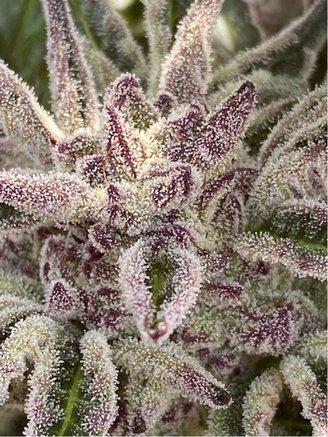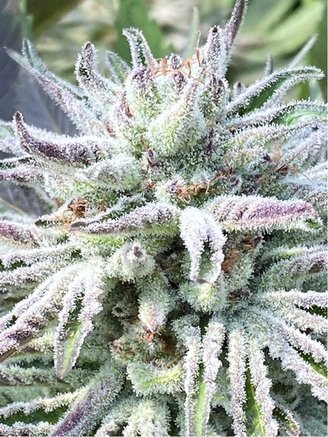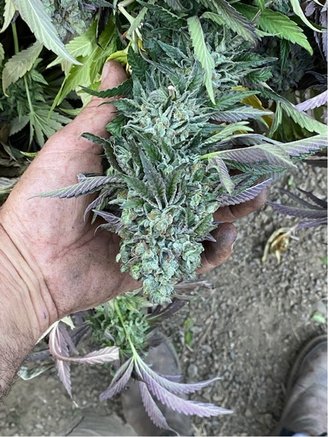Across the state of California, communities are discussing the importance of legacy cannabis farmers. According to the Origins Council, a Nor-Cal advocacy group, legacy farmers are those who have cultivated in historical producing regions for at least twenty years. Humboldt, Trinity, Mendocino, Sonoma, and other counties throughout the state have lots of them. Legacy farmers are of cultural and historical significance as their efforts paved the way for cannabis legalization and normalization. They have contributed significantly to their respective economic regions and have been outspoken advocates for personal freedom, environmental protection, and creating loving communities.

Ice Cream Cake Dep, 2021. Photo: Jesse Duncan.
Given mounting production in both legal and illegal channels, limited retail outlets, increasingly discerning consumers, and a predatory tax structure, legacy farmers are at risk. And it’s hard to see. Suicide rates among the cultivation community are rising, people are going out of business and some growers are left with little ability to replace the higher-than-average incomes growing cannabis historically provided.
While many consumers prefer outdoor flower as they believe it’s more environmentally responsible and generally higher in medicinal compounds like terpenes, acquiring dispensary shelf space is challenging for sun-grown farmers. Most localities across the state ban dispensaries and well-capitalized corporations pay slotting fees for shelf space…a pay-to-play arrangement of sorts. Vertically integrated corporations have their own dispensaries and tend to push proprietary products, while some distributors require large production to onboard farms as clients and ignore the small-lot production batches many farms produce. Legacy cultivators feel they are being pushed out of the industry they created and are crying afoul – cursing the corporatization of cannabis markets and rapidly declining wholesale prices.
A recent pricing report from New Leaf Data paints an unsettling picture stating that “of all the factors weighing on legacy state outdoor prices, market commoditization, succinctly demonstrated by outdoor growers selling almost exclusively to processors for extraction, is the most inevitable and least reversible.” While this is certainly not a popular conversation in sun-grown legacy regions, the data is becoming crystal clear. Currently, outdoor flower accounts for just 12% of sales volume among reported transactions in legal states. Last year at this time it was 26%, the year before it was 35%.
In other words, the market is changing, and quickly. The outdoor flower that Humboldt’s reputation was built on is rapidly losing market share and that has legacy farmers and communities nervous. While there is a renewed push to highlight the benefits of sun-grown products and provide them some shelf space, a sun-grown resurgence will play out slowly over time and will benefit only the best operators. Consumers and retailers are increasingly discerning and not all farms will meet the quality mark. With a proliferation of climate-controlled greenhouse flower across the state and explosive growth in the high terpene full spectrum extract markets, folks just aren’t as excited about outdoor as they once were.

Blueberry Dep, 2021. Photo: Jesse Duncan.
And begrudgingly, I get it. The last few seasons have been really smoky and a lot of outdoor product was tainted and caused problems for distribution companies and retailers. Additionally, cannabis is a plant where environmental exposure is critically important to outcomes. You can grow the same strain in one set of environmental conditions versus another and have the finished product look entirely different, so much so that you might not recognize it as the same cut. As we know from other industries, product quality and consistency are key. If I own a dispensary and want to put a SKU on 1/8-ounce jars of a certain type of flower, I don’t want it to look totally different from run to run or from farm to farm.
While for some cannabis connoisseurs the variability of cannabis expression is acknowledged, accepted, and revered, for others, it is clearly not. The simple truth is that indoor flower and greenhouse flower grown with strict environmental controls are far more consistent. This consistency, for many distributors and retail outlets, is highly desirable. Additionally, because of climate controls, indoor and greenhouse product is often more visually appealing with a heavier outer trichome layer, less leaf, and a tighter, more podded-out bud structure. While I make a living managing sun-grown operations and grow large, beautiful buds outside, I don’t find outdoor matches up visually with what one can do in a controlled environment. Although educated consumers understand that cannabis bag appeal is just one buying criterion, purchasers and retailers are currently emphasizing that over other attributes.
When growing light deprivation flowers outdoor it is harder to keep the flower color on point. Flowers tend to darken or bronze as they near maturity and not many operations use shade cloth the last two weeks to prevent scorch and terpene loss. For full-term flowers, I find they often disappoint visually after being dried and processed. While term buds look gorgeous on the vine, they often dry a bit sterile, at least when compared to indoor or greenhouse products. The buds look hairy and don’t boast of the same calyx formation as other grow types. After being trimmed the buds often lack contour and are rounded or oval and just don’t have the same character in most cases.
Additionally, I know some consumers who don’t like sun-grown flower as it gives them an allergic reaction when consumed. While recent evidence suggests cannabis pollen, and perhaps THC itself can trigger allergic reactions, outdoor flower is fully exposed to the elements. Just as our cars are dusted with pollen from surrounding vegetation, such is the case for outdoor-grown plants as well.
Nonetheless, there is still hope for sun-grown farmers. I personally prefer consuming full-term flower grown in native soil and many others do as well. Despite scary times, not all is lost for the ganja warriors of Humboldt and beyond. By aggressively focusing on sales/marketing, quality improvements, production increases, and cost savings, sun-grown farmers can stay in the game and eventually capitalize on better times to come with interstate markets and broad adoption of organic certification for cannabis.

Dosilato Dep, 2021. Photo: Jesse Duncan.
Sales & Marketing
Launching a brand is an expensive endeavor and is out of reach for many family farms. That said, several well-established brands source products from partner farms. These brands have already done the leg work in creating an online presence and securing valuable dispensary shelf space. Some are fans of sun-grown flower and have an ever-expanding footprint that family farms can benefit from. Co-branding or piggybacking on the success of a reputable brand, getting product into jars or pouches, and ultimately achieving retail shelf space can radically improve your price per pound. Of course, without an exceptionally high-quality product, this will never happen. In Humboldt, partnering with brands is often viewed as heresy or as selling out, but for some, it can be a viable path forward.
Quality Improvements
Having lived in Humboldt my whole life and having consumed cannabis for nearly three decades, I’ve seen that flower has largely declined in quality here in the Triangle. Weed tastes greener and smokes hotter and harsher than it did a couple of decades back. Bowls don’t ash like they used to and instead, often char out and are largely un-smokable for me.
High-quality or top-shelf commercial flower is visually appealing with a tight, podded-out structure and heavy outer trichome layer. It tastes like it smells and goes down smooth while delivering the desired effect. Many “premium” flowers are poorly formed, ugly, hairy, and harsh. By focusing on genetics, plant structure, pruning, organic or quasi-organic nutrient delivery, sugar content, artful stress, and an active flushing program, your flower can stand out from the rest and get some real momentum in the marketplace.
Increasing Production
Increasing production is a real possibility for most farms, even those doing quite well. I’ll never forget several years back when a retired soil scientist told us we could increase production by 20% or more if we got serious about soil structure and biology. Note the garden he toured was my mentor Mike’s and had two plants that went over 13 pounds.
Whether growing in soil or another medium, focusing on more advanced techniques like crop steering or simply manipulating the size and shape of your plants through topping, pruning, coring, and opening can meaningfully impact your bag weight. Supplemental feeding – especially through a foliar regime that pushes nutrients through the leaves – is another way to radically boost yields, as are strain selection and quality of starts.
Of course, every grower you talk to is killing it. Clearly not the case as I still see tons of Instagram posts where farmers are growing lanky Christmas trees instead of more stump-like bushes that really pack on the weight. Many trellises’ have huge canopy gaps and lots of finished tops aren’t even fist-sized.
Cost Savings
During the multi-decade cannabis bull market where prices were high, cultivators could be a bit loose with the budget. They could “overpay” for products and services and many did. As things have tightened up meaningfully, largely absentee farm owners should get back in the dirt personally as a way to reduce labor costs. Putting goods and services out for bid is another way to potentially save. Rather than simply accepting “dope grower” prices for inputs, construction, or consulting services, requesting discounts, purchasing in bulk, or shopping around can lead to significant savings.
National legalization is moving slower than many of us would like. Biden is not a huge fan of recreational cannabis and there is growing chatter that republicans may make a strong showing in the mid-term elections. Even with a national marketplace, some states will seek to protect their own producers and limit imports from other places. Given such, I expect another tough year or several years here on the west coast. Upping our cultivation game, being proactive concerning sales and marketing, and tightening our belts seem like the best path forward. The economic vibrancy of our community is depending on us so I wish everyone well.
###
Jesse Duncan is a lifelong Humboldt County resident, a father of six, a retired financial advisor, and a full-time commercial cannabis grower. He is also the creator of NorCal Financial and Cannabis Consulting, a no-cost platform that helps small farmers improve their cultivation, business, and financial skills. Please check out his blog at, his Instagram at jesse_duncann, and connect with him on Linkedin.
CLICK TO MANAGE